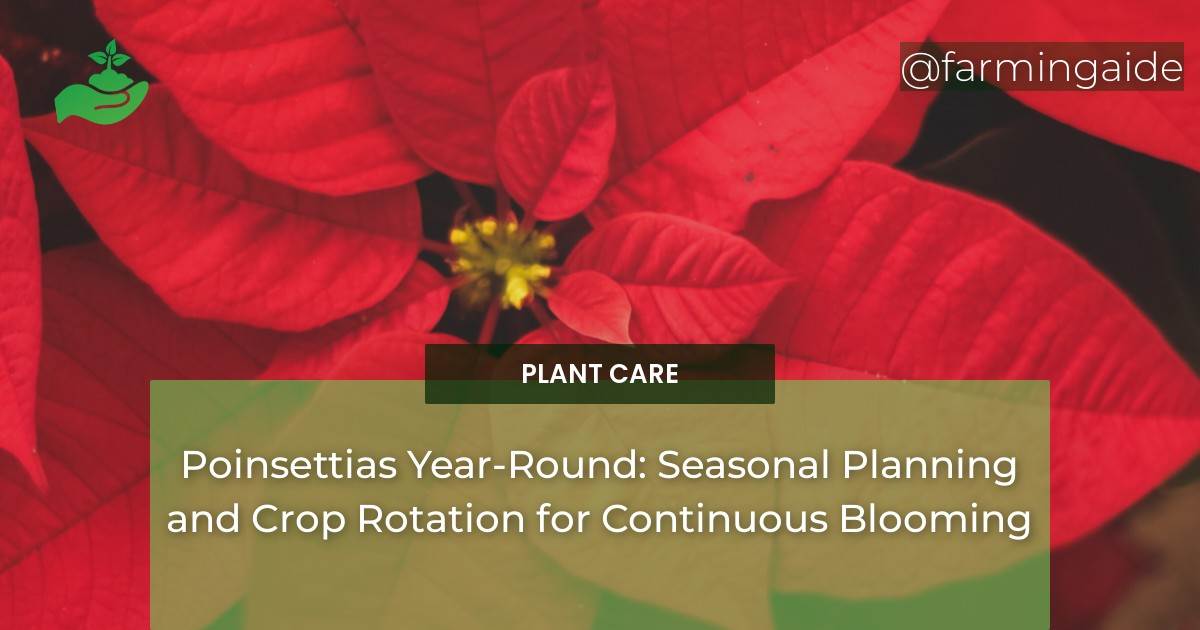Poinsettias are a staple in the horticulture industry, known for their vibrant red and green foliage that adds a festive touch to any space. But did you know that with proper planning and care, poinsettias can bloom year-round? In this article, we will explore the importance of poinsettias in the horticulture industry and the goal of achieving continuous blooming. We will also delve into the various aspects of poinsettia cultivation, including choosing the right variety, soil management and composting, pest and disease control, sustainable gardening practices, and seasonal planning for continuous blooming. Additionally, we will discuss the benefits of crop rotation and provide tips for success in achieving poinsettia seasonality. So let’s get started!
Importance of Poinsettias in Horticulture Industry
Poinsettias are one of the top-selling potted plants in the United States, with over 34 million sold each year. They are a significant source of income for the horticulture industry, especially during the holiday season. Poinsettias are also popular for their versatility, as they can be used as cut flowers, in wreaths and garlands, and as outdoor landscape plants. With such high demand, it is crucial to understand the best practices for poinsettia cultivation to ensure a continuous supply of healthy and vibrant plants.
Goal of the Article
The goal of this article is to provide comprehensive information on achieving continuous blooming with poinsettias. We will cover all the necessary aspects of poinsettia cultivation, from selecting the right variety to proper care and maintenance throughout the year. By the end of this article, you will have a thorough understanding of how to extend the blooming period of poinsettias and enjoy their beauty year-round.
Choosing and Cultivating Poinsettias
Choosing the right variety of poinsettias is crucial for achieving continuous blooming. Some varieties are better suited for indoor cultivation, while others thrive in outdoor landscapes. It is essential to select a variety that is suitable for your specific growing conditions and desired blooming period. Once you have chosen the right variety, proper planting techniques, such as providing adequate drainage and spacing, are essential for the health and growth of poinsettias.
Throughout the year, poinsettias require proper care and maintenance to ensure continuous blooming. This includes regular watering, fertilizing, and pruning to promote healthy growth and prevent diseases. It is also crucial to monitor for any signs of stress or pest infestations and take appropriate measures to address them promptly.
Soil Management and Composting
Soil health is vital for the growth and blooming of poinsettias. It is recommended to use well-draining, nutrient-rich soil for poinsettia cultivation. Composting is an excellent way to improve soil quality and provide essential nutrients to poinsettias. Compost can be made from a variety of organic materials, such as kitchen scraps, yard waste, and manure. Adding compost to the soil can also help with water retention and prevent soil erosion.
Pest and Disease Control
Like any plant, poinsettias are susceptible to pests and diseases. Common pests that can affect poinsettias include aphids, whiteflies, and spider mites. It is essential to regularly inspect poinsettias for any signs of pest infestations and take preventative measures, such as using insecticidal soap or introducing natural predators, to control them. Diseases, such as powdery mildew and root rot, can also affect poinsettias, and proper care and maintenance can help prevent these issues.
Sustainable Gardening Practices
In recent years, there has been a growing emphasis on sustainable gardening practices. These practices not only benefit the environment but also promote the health and growth of plants, including poinsettias. Some sustainable gardening techniques that can be applied to poinsettia cultivation include using organic fertilizers, conserving water, and using eco-friendly pest control methods.
Seasonal Planning for Continuous Blooming
Understanding the natural blooming cycle of poinsettias is crucial for planning for continuous blooming. Poinsettias typically bloom in the winter months, but with proper care and manipulation of light and temperature, they can be encouraged to bloom at other times of the year. Planning for continuous blooming also involves selecting the right variety and providing proper care and maintenance throughout the year.
Tricks for extending the blooming period of poinsettias include pinching back the plants to promote bushier growth, providing adequate light and temperature, and avoiding stressors such as overwatering or sudden changes in environment.
Crop Rotation Techniques
Crop rotation is the practice of growing different crops in the same area in sequential seasons. This technique is essential for maintaining soil health and preventing the buildup of pests and diseases. Poinsettias can benefit from crop rotation, and it is recommended to rotate them with other plants that have different nutrient requirements. Proper timing and methods for crop rotation can help ensure the continuous blooming of poinsettias.
>Can I Use Seasonal Planning and Crop Rotation to Keep Poinsettias Blooming Year-Round in My Home Garden?
Yes, you can use seasonal planning and crop rotation to keep poinsettias blooming year-round in your home garden. By following these tips for growing poinsettias, you can ensure that your plants thrive and produce beautiful blooms throughout the year. Rotate them to different spots and optimize their growth with seasonal care.
Conclusion
In conclusion, achieving continuous blooming with poinsettias requires careful planning and proper care and maintenance. By selecting the right variety, providing proper soil management and composting, controlling pests and diseases, and implementing sustainable gardening practices, you can enjoy the beauty of poinsettias year-round. Additionally, understanding the natural blooming cycle of poinsettias and implementing crop rotation techniques can help extend their blooming period. With these tips and techniques, you can become a pro at achieving poinsettia seasonality and impress your friends and family with your beautiful and vibrant plants.


